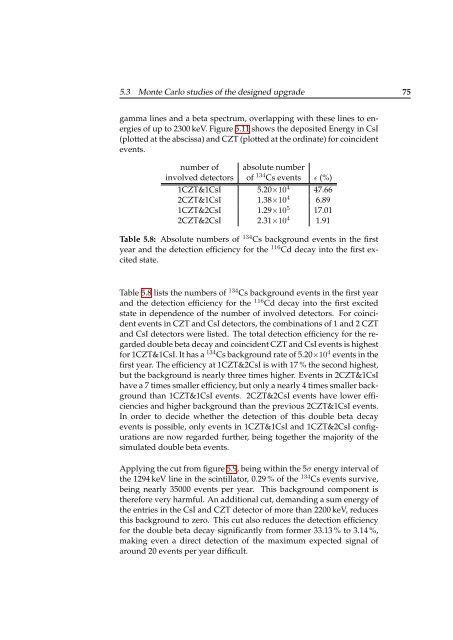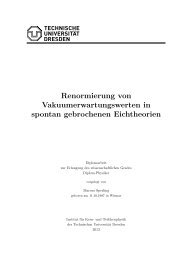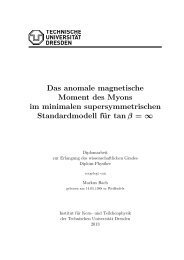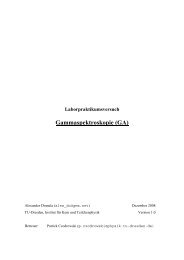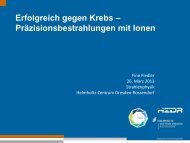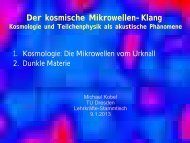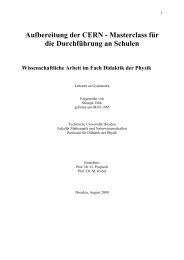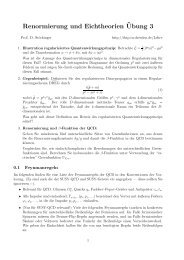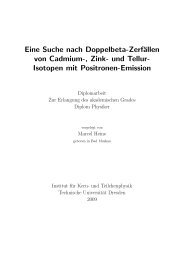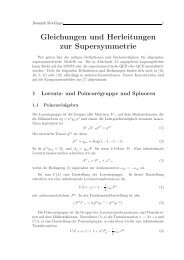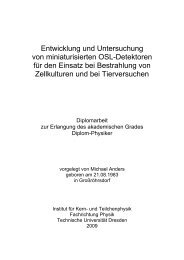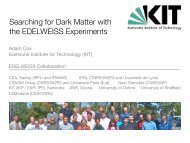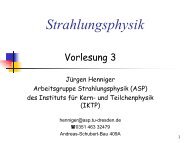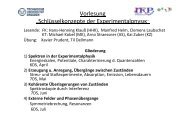a design study for a cobra upgrade to - Institut für Kern- und ...
a design study for a cobra upgrade to - Institut für Kern- und ...
a design study for a cobra upgrade to - Institut für Kern- und ...
Create successful ePaper yourself
Turn your PDF publications into a flip-book with our unique Google optimized e-Paper software.
5.3 Monte Carlo studies of the <strong>design</strong>ed <strong>upgrade</strong> 75<br />
gamma lines and a beta spectrum, overlapping with these lines <strong>to</strong> energies<br />
of up <strong>to</strong> 2300 keV. Figure 5.11 shows the deposited Energy in CsI<br />
(plotted at the abscissa) and CZT (plotted at the ordinate) <strong>for</strong> coincident<br />
events.<br />
number of absolute number<br />
involved detec<strong>to</strong>rs of 134 Cs events ɛ (%)<br />
1CZT&1CsI 5.20×10 4 47.66<br />
2CZT&1CsI 1.38×10 4 6.89<br />
1CZT&2CsI 1.29×10 5 17.01<br />
2CZT&2CsI 2.31×10 4 1.91<br />
Table 5.8: Absolute numbers of 134 Cs backgro<strong>und</strong> events in the first<br />
year and the detection efficiency <strong>for</strong> the 116 Cd decay in<strong>to</strong> the first excited<br />
state.<br />
Table 5.8 lists the numbers of 134 Cs backgro<strong>und</strong> events in the first year<br />
and the detection efficiency <strong>for</strong> the 116 Cd decay in<strong>to</strong> the first excited<br />
state in dependence of the number of involved detec<strong>to</strong>rs. For coincident<br />
events in CZT and CsI detec<strong>to</strong>rs, the combinations of 1 and 2 CZT<br />
and CsI detec<strong>to</strong>rs were listed. The <strong>to</strong>tal detection efficiency <strong>for</strong> the regarded<br />
double beta decay and coincident CZT and CsI events is highest<br />
<strong>for</strong> 1CZT&1CsI. It has a 134 Cs backgro<strong>und</strong> rate of 5.20×10 4 events in the<br />
first year. The efficiency at 1CZT&2CsI is with 17 % the second highest,<br />
but the backgro<strong>und</strong> is nearly three times higher. Events in 2CZT&1CsI<br />
have a 7 times smaller efficiency, but only a nearly 4 times smaller backgro<strong>und</strong><br />
than 1CZT&1CsI events. 2CZT&2CsI events have lower efficiencies<br />
and higher backgro<strong>und</strong> than the previous 2CZT&1CsI events.<br />
In order <strong>to</strong> decide whether the detection of this double beta decay<br />
events is possible, only events in 1CZT&1CsI and 1CZT&2CsI configurations<br />
are now regarded further, being <strong>to</strong>gether the majority of the<br />
simulated double beta events.<br />
Applying the cut from figure 5.9, being within the 5σ energy interval of<br />
the 1294 keV line in the scintilla<strong>to</strong>r, 0.29 % of the 134 Cs events survive,<br />
being nearly 35000 events per year. This backgro<strong>und</strong> component is<br />
there<strong>for</strong>e very harmful. An additional cut, demanding a sum energy of<br />
the entries in the CsI and CZT detec<strong>to</strong>r of more than 2200 keV, reduces<br />
this backgro<strong>und</strong> <strong>to</strong> zero. This cut also reduces the detection efficiency<br />
<strong>for</strong> the double beta decay significantly from <strong>for</strong>mer 33.13 % <strong>to</strong> 3.14 %,<br />
making even a direct detection of the maximum expected signal of<br />
aro<strong>und</strong> 20 events per year difficult.


